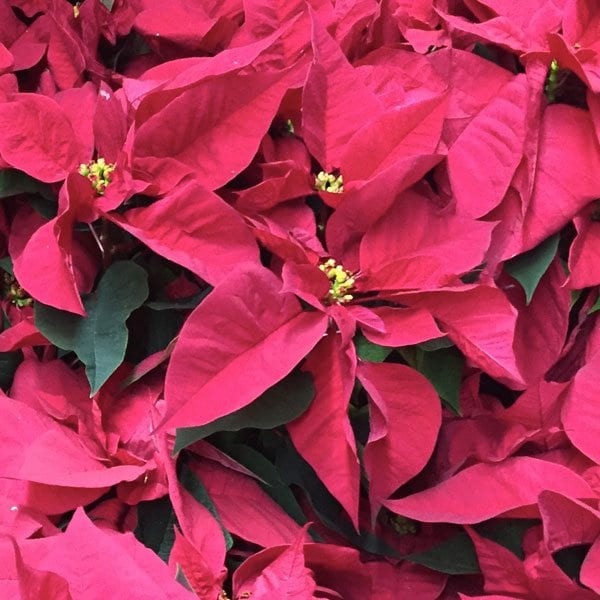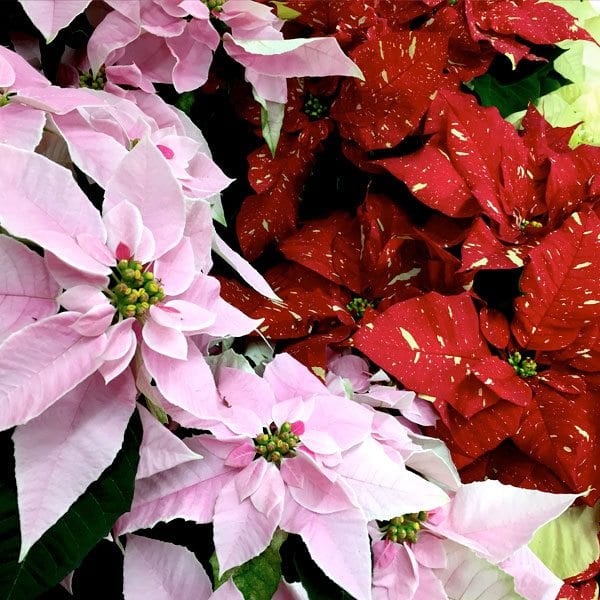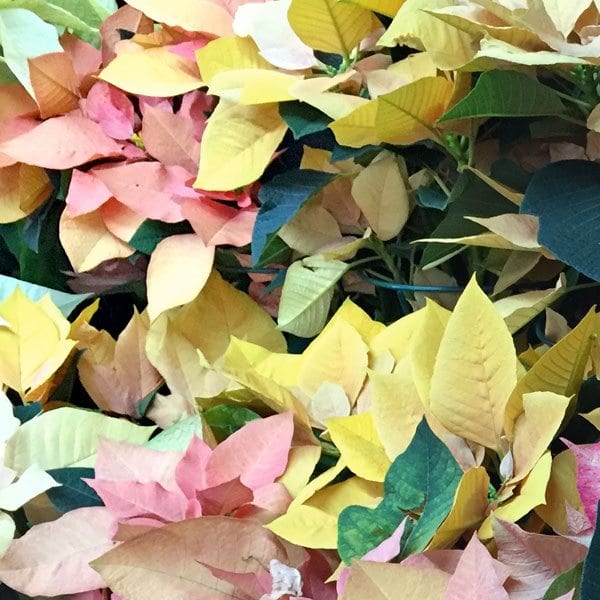Poinsettia
Common names: poinsettia
Description: Poinsettias are a popular gift and home decoration for the Christmas season. Flower-like bracts as large as 12 inches across grow on these potted plants and may be red, white, pink, yellow, speckled or variegated; these bracts surround the tiny, yellow true flowers.
Despite the longstanding myth, the poinsettia is the most widely tested plant and has been proven to be non-toxic.
Special Care: Water thoroughly when soil surface feels dry remove excess water from trays and foil covers. Bright, indirect light will prolong their life.
Poinsettia Colors and Varieties
Poinsettias are a longstanding favorite as gifts and decor for the Christmas holidays.
While the standard three- to six-bloom red poinsettia is the most popular, there are several other sizes, shapes and colors available.
Colors can range from creamy white to shades of pink and orange to the traditional red. Also available are marbled bracts of pink and white as well as pink flecks on red. Poinsettias can be purchased in miniature sizes, trees, hanging baskets and even as fresh cut flowers.
History and Legend of the Poinsettia
Poinsettias were first introduced to the United States in 1825 by Joel Robert Poinsett, amateur botanist and first ambassador to Mexico. He introduced the plant to the United States when he brought some cuttings to his plantation in Greenwood, South Carolina.
December 12 is National Poinsettia Day, an official day set aside to enjoy this symbol of holiday cheer. It was established upon the death of Mr. Poinsett to honor him and the plant he made famous. He died in 1851.
Poinsettias are native to Mexico, where they grow wild. The enchanting legend of the poinsettia dates back several centuries, to a Christmas Eve in Mexico when a little girl named Pepita had no gift to present to the Christ child. Her cousin Pedro urged her to give a humble gift. So, on her way to church she gathered some weeds she found along the road. As she approached the altar, a miracle happened: The weeds blossomed into brilliant flowers. Then they were called Flores de Noche Buena – Flowers of the Holy Night. Now they are called poinsettias.
Poinsettia Care Tips
Poinsettias are one of the longest-lasting blooming plants available to consumers.
To choose the perfect poinsettia:
- Pick a plant with small, tightly clustered buds in the center.
- Look for crisp, bright, undamaged foliage.
- Avoid plants displayed in drafty or crowded areas.
To keep the poinsettia blooming:
- When surface soil is dry to the touch, water thoroughly. Discard excess water in the saucer.
- To prolong color, keep a temperature range of 60 degrees for night and 72 degrees for day. High humidity is preferable.
- Place plant away from hot or cold drafts, and protect from cold winds.
To rebloom for the next season:
- During winter, continue to follow holiday upkeep tips.
- March 17 (St. Patrick’s Day): When bracts fade, cut stems back to eight inches above soil line.
- Continue to water regularly.
- Lightly fertilize with a good, balanced all-purpose fertilizer every three to four weeks.
- When temperatures are warm, place plant outdoors; first in indirect, then direct sunlight. Avoid temperatures below 50 degrees throughout the summer.
- July 4 (Independence Day): Cut back new growth stems. Repot if needed.
- Early September (Labor Day): Move plant inside. Provide six or more hours of direct light.
- October 1 through mid-December: Confine plant to complete darkness for 14 hours, giving it 10 hours of natural light daily. This will set the buds and cause bracts to color.
Poinsettia Toxicity Myth
The poinsettia is the most widely tested consumer plant on the market today, proving the myth about the popular holiday plant to be false:
- Scientific research from The Ohio State University has proved the poinsettia to be non-toxic. All parts of the plant were tested, including the leaves and sap.
- According to POISINDEX, the national information center for poison control centers, a child would have to ingest 500-600 leaves in order to exceed the experimental doses that found no toxicity.
- A study by Children’s Hospital in Pittsburgh and Carnegie Mellon University found that out of 22,793 reported poinsettia exposures there was essentially no toxicity significance of any kind. The study used national data collected by the American Association of Poison Control Centers.
- The National Capital Poison Center lists the poinsettia among non-poisonous plants
- “Poinsettia exposures have good outcomes … just as we thought” posted by the American Journal of Emergency Medicine
- “Holiday Plants with Toxic Misconceptions” posted by the Western Journal of Emergency Medicine (WestJEM)
- “Festive medical myths” posted on BMJ.com (British Medical Journal).
- “Scientists Shed Light On Festive Medical Myths” posted on NPR. Click here for a PDF.
- “Keeping the Holidays Safe From Hidden Poisons” by WebMd
Poinsettia and Pets
As with any non-food product, the poinsettia is not meant to be eaten and can cause varying degrees of discomfort; therefore, the plant should be kept out of the reach of young children and curious pets.
- The American Society for the Prevention of Cruelty to Animals reports that the poinsettia could be “irritating to the mouth and stomach, sometimes causing vomiting, but generally over-rated in toxicity.”
- The American Veterinary Medicine Association of America (AVMA) states: “While poinsettia is not deadly as popular legend would have it, it could still cause an upset stomach if consumed.”
- The Purdue Plant & Pest Diagnostic Laboratory advises pet owners: “Wash sap off the animal to prevent further ingestion. Call a veterinarian if the eyes are affected, or if signs do not resolve in a few minutes.”
- According to BMJ (British Medical Journal), one study, “looking at poinsettia ingestion by rats, could not find a toxic amount of poinsettia, even at amounts that would be the equivalent of 500-600 poinsettia leaves or nearly a kilogram of sap.”
Poinsettia and Latex Allergies
According to the American Latex Allergy Association, only about 1 percent to 6 percent of the general population is allergic to latex, and “… one would have to have significant contact with the poinsettia plant’s latex directly to have an allergic reaction … only a small drop of latex that can be immediately wiped off of the skin is unlikely to cause an allergic reaction.”






